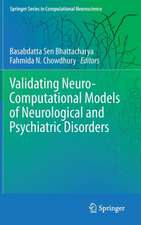Computational Neurology and Psychiatry: Springer Series in Bio-/Neuroinformatics, cartea 6
Editat de Péter Érdi, Basabdatta Sen Bhattacharya, Amy L. Cochranen Limba Engleză Paperback – 18 iul 2018
| Toate formatele și edițiile | Preț | Express |
|---|---|---|
| Paperback (1) | 1051.84 lei 6-8 săpt. | |
| Springer International Publishing – 18 iul 2018 | 1051.84 lei 6-8 săpt. | |
| Hardback (1) | 1058.28 lei 6-8 săpt. | |
| Springer International Publishing – 9 feb 2017 | 1058.28 lei 6-8 săpt. |
Preț: 1051.84 lei
Preț vechi: 1314.80 lei
-20% Nou
Puncte Express: 1578
Preț estimativ în valută:
201.28€ • 215.23$ • 167.81£
201.28€ • 215.23$ • 167.81£
Carte tipărită la comandă
Livrare economică 17 aprilie-01 mai
Preluare comenzi: 021 569.72.76
Specificații
ISBN-13: 9783319842844
ISBN-10: 3319842846
Ilustrații: VI, 448 p. 157 illus., 119 illus. in color.
Dimensiuni: 155 x 235 mm
Greutate: 0.64 kg
Ediția:Softcover reprint of the original 1st ed. 2017
Editura: Springer International Publishing
Colecția Springer
Seria Springer Series in Bio-/Neuroinformatics
Locul publicării:Cham, Switzerland
ISBN-10: 3319842846
Ilustrații: VI, 448 p. 157 illus., 119 illus. in color.
Dimensiuni: 155 x 235 mm
Greutate: 0.64 kg
Ediția:Softcover reprint of the original 1st ed. 2017
Editura: Springer International Publishing
Colecția Springer
Seria Springer Series in Bio-/Neuroinformatics
Locul publicării:Cham, Switzerland
Cuprins
From the Content.- Introduction.- Outgrowing Neurological Diseases: Microcircuits, Conduction Delay and Dynamic Diseases.-
Extracellular Potassium and Focal Seizures – Insight From in Silico Study.-
Time Series and Interactions: Data Processing in Epilepsy Research.
Time Series and Interactions: Data Processing in Epilepsy Research.
Textul de pe ultima copertă
This book presents the latest research in computational methods for modeling and simulating brain disorders. In particular, it shows how mathematical models can be used to study the relationship between a given disorder and the specific brain structure associated with that disorder. It also describes the emerging field of computational psychiatry, including the study of pathological behavior due to impaired functional connectivity, pathophysiological activity, and/or aberrant decision-making. Further, it discusses the data analysis techniques that will be required to analyze the increasing amount of data being generated about the brain. Lastly, the book offers some tips on the application of computational models in the field of quantitative systems pharmacology. Mainly written for computational scientists eager to discover new application fields for their model, this book also benefits neurologists and psychiatrists wanting to learn about new methods.
Caracteristici
Reports on computational studies of brain and mind disease Describes computational models and their use in practice Includes background information on the biology of the diseases With take-home messages for both neurologists and computer scientists Includes supplementary material: sn.pub/extras



































